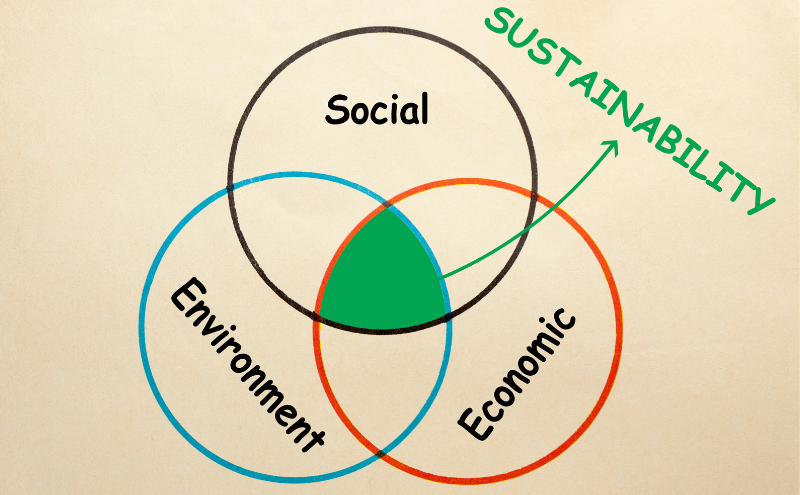
Sustainability is a complex concept often represented diagrammatically. One commonly used representation is the three pillars of sustainability: economic viability, environmental protection, and social equity. These pillars form the foundation for achieving a sustainable future.
While other dimensions such as technical feasibility, political legitimacy, and institutional capacity can also be considered, our focus in this course is on the 3 pillars. They provide a framework that helps us navigate the complexities associated with terms like “development” and assess whether it has positive or negative impacts.
The Impact of Global Population Growth
The global population surpassed 7 billion people in 2015, a significant increase compared to a century ago when there were only about 1.6 billion people in the world. With the population projected to continue growing, the strain on Earth’s resources will inevitably intensify.
However, it’s important to note that consumption patterns are not evenly distributed across the world. One glaring indicator of unsustainability is the gross misdistribution of wealth. More than a third of the global population still lives in poverty, lacking access to essential resources like energy, water, and food.
The Growing Gap and the Importance of Social Equity
The exponential population growth is more pronounced in developing countries, while resource consumption and pollution are higher in developed countries. This widening gap between the two ends of the spectrum raises concerns. Sustainability should not only focus on ecological aspects but also on humanity, aiming to reduce inequality and ensure a basic standard of living for all.
Viewpoints for Sustainability
Motivations for exploring sustainability can vary depending on individual perspectives. Here are three common viewpoints:
- The Ecologist: This perspective goes beyond perceiving the human race as merely coexisting with the planet and its resources. Ecologists view humanity as an inseparable part of nature, recognizing the intricate connections and interdependencies between all living beings and ecosystems. They believe that the preservation of the planet is essential because both nature and humanity have inherent value and contribute to the overall balance and health of the Earth. Ecologists advocate for the protection of ecosystems, biodiversity, and natural resources to ensure the long-term well-being of both the planet and future generations. They emphasize the intrinsic rights of nature and promote sustainable practices that prioritize conservation, restoration, and the harmonious coexistence of all living organisms.
- The Environmentalist: Environmentalists perceive nature and the planet as separate entities from the human race, yet they acknowledge the critical role they play in supporting human life and well-being. They advocate for responsible stewardship of the environment, recognizing that the Earth’s resources are finite and must be managed sustainably to meet the needs of current and future generations. Environmentalists prioritize the preservation of ecosystems, protection of endangered species, reduction of pollution and waste, and the promotion of renewable energy sources. Their motivation lies in ensuring a healthy environment that sustains human survival, promotes ecological balance, and allows for the evolution and progress of society in harmony with nature.
- The Economist: Economists approach sustainability from the perspective of market forces and the economic implications of unsustainable practices. They recognize that a consumer-driven culture, characterized by excessive resource consumption and environmental degradation, poses risks to the long-term stability and well-being of societies. However, economists believe that market mechanisms, when guided by appropriate policies and regulations, can drive positive change and avert sustainability crises. They have faith in the power of innovation and technological advancements to address environmental challenges. The economist viewpoint suggests that by aligning economic incentives with sustainable practices, businesses and industries can adopt more environmentally friendly approaches. They emphasize the importance of market-driven solutions, such as carbon pricing, sustainable investment strategies, and green technologies, to achieve both economic prosperity and environmental sustainability.
While each perspective has its unique emphasis and motivations, they all contribute to the broader goal of sustainability by highlighting different aspects and approaches. The integration of these viewpoints can foster comprehensive and holistic strategies for achieving a more sustainable future, considering the ecological, social, and economic dimensions of human-environment interactions.
Understanding Your Motivations
It is crucial to reflect on your motivations for seeking sustainability. This introspection can help you articulate your understanding of sustainability and determine your commitment to achieving it. Consider what drives your interest—economic viability, environmental protection, social equity—and which viewpoint aligns most closely with your perspective.
By embracing the three pillars of sustainability and understanding our individual motivations, we can work towards a more sustainable future that balances economic, environmental, and social considerations.


